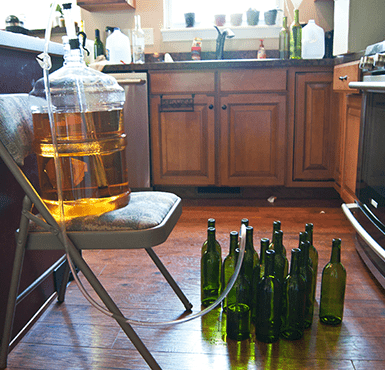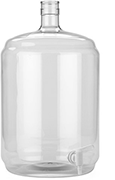 Bottling day for my Pinot Chardonnay has finally arrived! This is my second attempt at bottling wine from a carboy.
Bottling day for my Pinot Chardonnay has finally arrived! This is my second attempt at bottling wine from a carboy.
If you recall, I’d been letting the wine sit for a couple of months to help settle and clarify (per the instructions on the concentrate can). At the end of this time, I decided that the wine was not yet clear enough so I added some clarifying agents to speed things up a little bit. I think my fining agent might have been going bad (can they do that??? I’ve only had them for a couple of months), because it was kind of difficult to remove the substance from the pouch (it was solidifying and kind of “crunchy”). Anyway, I added what I could in and a couple days later still seemed to do the trick.
 At the same time that all this clarifying was going along, ECKraus came to the rescue and sent me my replacement carboy spigot that I had basically destroyed a week or so prior. This meant that I could transfer my Pinot Chardonnay from the carboy that it was in into the carboy with a spigot, since I really liked bottling wine from the spigot instead of using the racking tube. Well, to be fair, I’ve only tried to bottle using the spigot and have not yet tried bottling wine using the siphoning tube, but since it’s been going so well for me I figured why stop now!
At the same time that all this clarifying was going along, ECKraus came to the rescue and sent me my replacement carboy spigot that I had basically destroyed a week or so prior. This meant that I could transfer my Pinot Chardonnay from the carboy that it was in into the carboy with a spigot, since I really liked bottling wine from the spigot instead of using the racking tube. Well, to be fair, I’ve only tried to bottle using the spigot and have not yet tried bottling wine using the siphoning tube, but since it’s been going so well for me I figured why stop now!
Only “bad” thing that happened when transferring the wine from the first carboy to the “spigotted” carboy was that I accidentally mixed up the sediment on the bottom a little bit and so there was some little bits of things transferred into the wine bottles after bottling. I suppose I could have let the wine sit for a longer period of time to allow it to settle out, however, I was inpatient and just decided to go ahead and bottle even if it was a little cloudy. The only other thing that could have helped at this point would have been if I had a filtering system. That’s still on the list of things to buy, for sure!
 The most exciting part of bottling my wine was using my new hand corker for the first time! The first time I bottled wine, I used those small corks with the plastic tops on them that I could just push in with my hand. This time, I wanted to go a little more “authentic” and decided to put standard corks in my wine bottles. Since I currently have a very small batch operation, I felt as though the hand corker would be more than enough, and maybe if I ever increase production I could upgrade to a larger floor corker.
The most exciting part of bottling my wine was using my new hand corker for the first time! The first time I bottled wine, I used those small corks with the plastic tops on them that I could just push in with my hand. This time, I wanted to go a little more “authentic” and decided to put standard corks in my wine bottles. Since I currently have a very small batch operation, I felt as though the hand corker would be more than enough, and maybe if I ever increase production I could upgrade to a larger floor corker.
I was admittedly a little nervous before I corked my first wine bottle. How easy would using this device actually be? How much “elbow grease” would I need? Turns out—it’s super easy and I didn’t even break a sweat. First, per the instructions on the corks, I boiled them for a short period of time to get them a little more able to be compressed. Then, I simply followed the instructions on the box of the hand corker and voila! Corking a bottle of wine couldn’t be easier! Everything just went so smooth and at first I was convinced I must have done something wrong since I barely put any effort into the job. I suppose if you do it correctly, it’s a cinch!
Now time to let the bottles sit upright for a few days while the corks expand, then off to bed on their sides they will go for a while!
All in all, bottling my wine from the carboy went pretty easily. I did get a little sediment mixed up, but I’ll have to chalk that up as a learning experience.
————————————————————————————————————-
 My name is Leigh Erwin, and I am a brand-spankin’ new home winemaker! E. C. Kraus has asked me to share with you my journey from a first-time dabbler to an accomplished home winemaker. From time to time I’ll be checking in with this blog and reporting my experience with you: the good, bad — and the ugly.
My name is Leigh Erwin, and I am a brand-spankin’ new home winemaker! E. C. Kraus has asked me to share with you my journey from a first-time dabbler to an accomplished home winemaker. From time to time I’ll be checking in with this blog and reporting my experience with you: the good, bad — and the ugly.

im using a carboy for the first time how full should it be? thanks
Jason, you do not want to start your wine in a carboy. You would rather it be in an open, food-grade, buck fermenter. This is to accommodate for the foaming. Once the fermentation starts to calm down (around day 5), you will want to siphon the wine off the sediment into a carboy to finish. You want the wine to be up to the neck, or past the shoulder of the carboy.